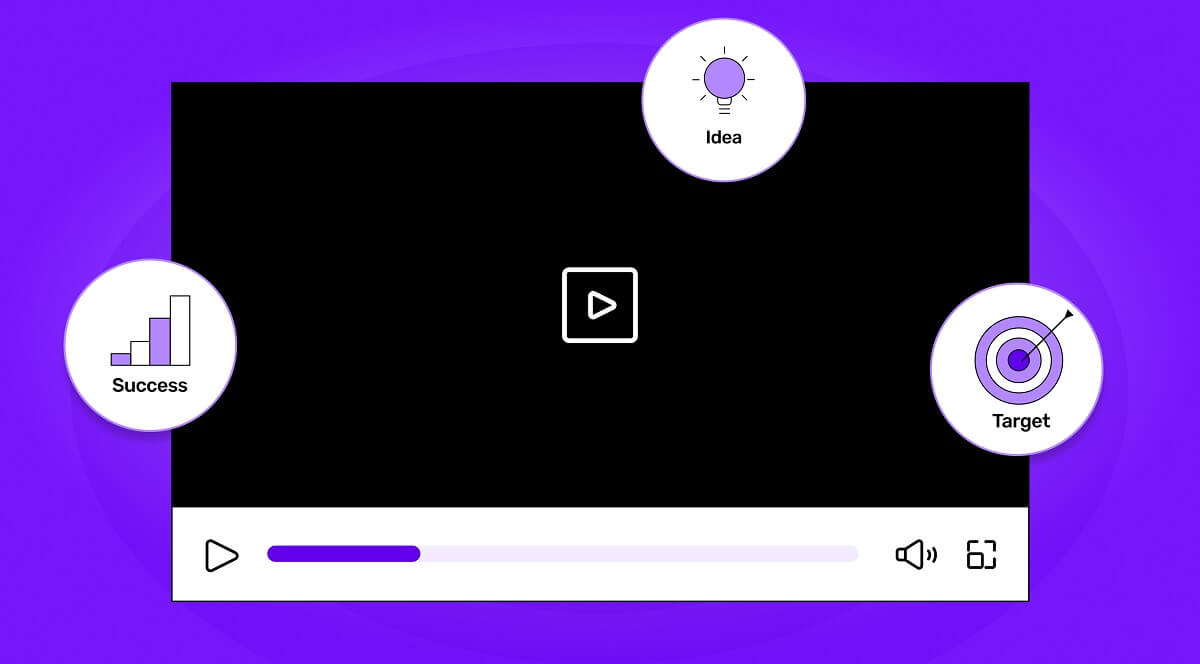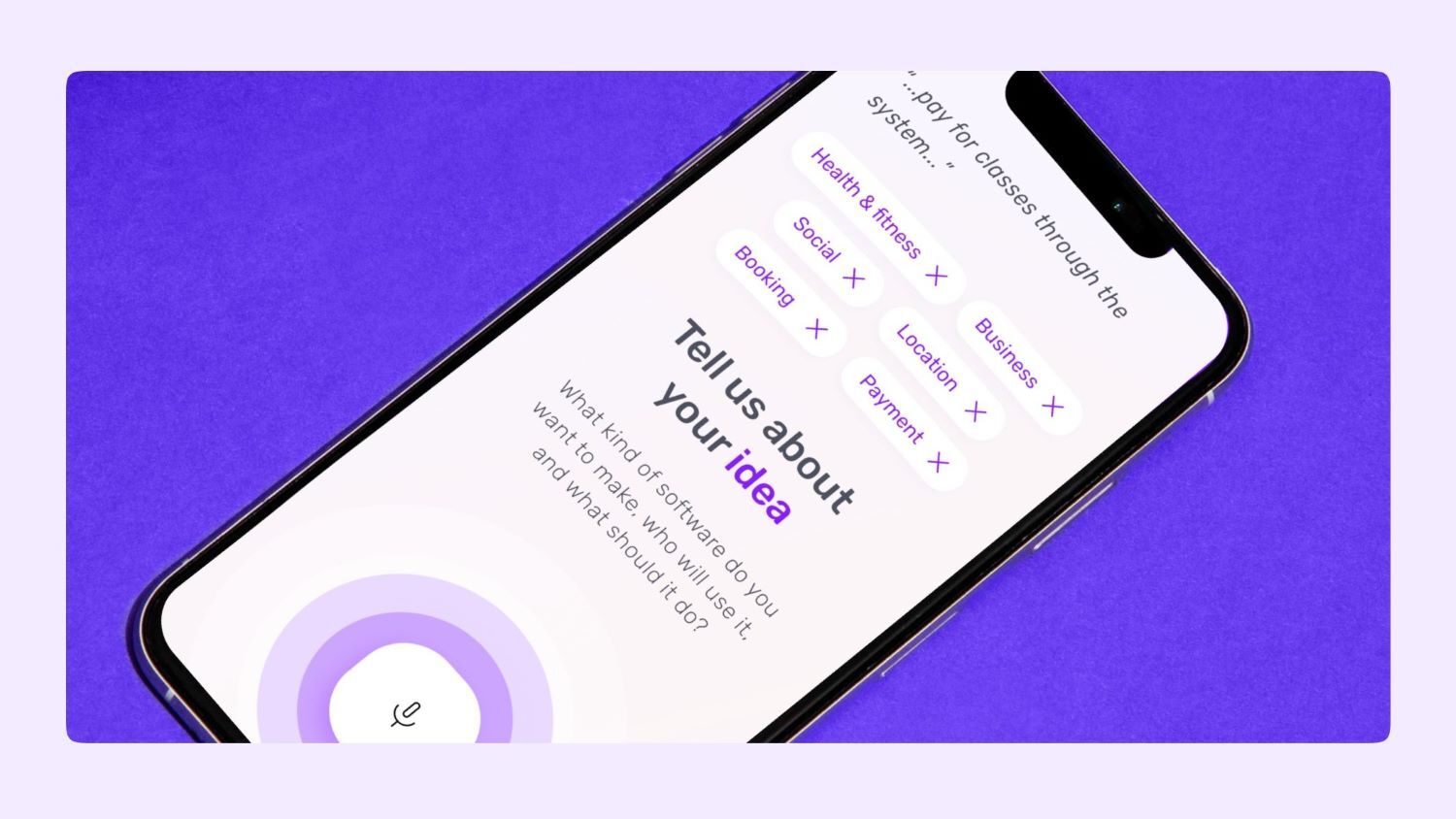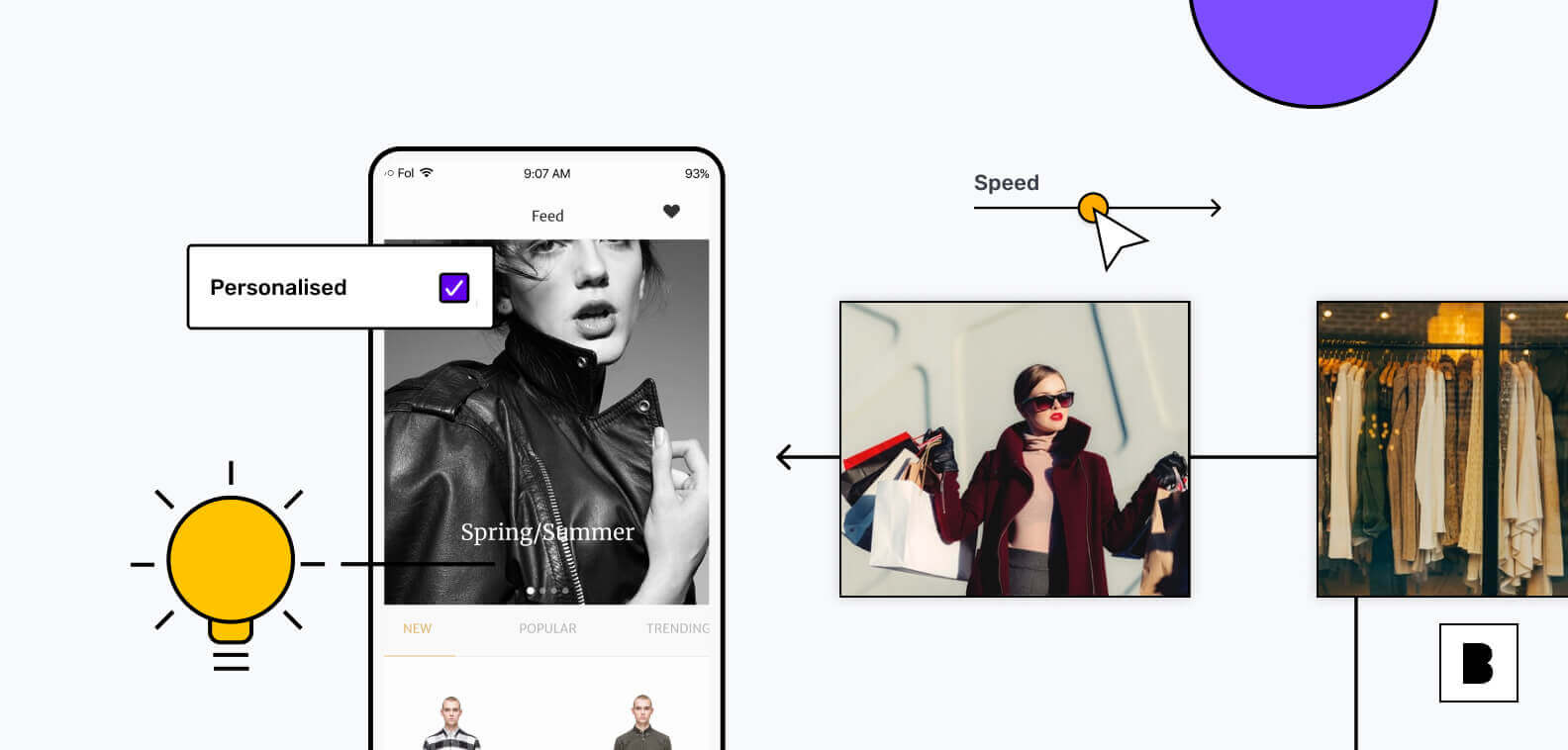TikTok surpassed Google as the world’s most accessed web domain in 2021 and has around 1 billion active monthly users.
Clearly, the thirst for video content is huge. And this is something retailers need to quench if they’re to sell online effectively.
But it’s not just a case of creating videos. You need a video marketing strategy to effectively communicate with your customers.
To make them aware of your brand, build trust and eventually guide them through to purchase, video is your secret weapon. Especially when it’s viewed as part of your existing business, marketing and content strategies.
In this blog, we explain how you can create a video marketing strategy that wins big for your business. Use the menu below or keep scrolling 👇
What is a video marketing strategy?
Video marketing strategies are plans that help you achieve your long-term video marketing goals. As these goals are an extension of your wider business, marketing and content strategies, video marketing should complement a range of activities. These include brand building, blog posts, social media ads and conversion rate optimisation.
Why is a video marketing strategy important?
Video is the number one format used by marketers in their content strategy. So pushing random videos live and praying they work won’t work. Only pre-planned activity with defined audiences, set goals and clear messaging can help you achieve meaningful results.
How can you create a video marketing strategy?
Already created your business, marketing and/or content strategy yet? Then you’re in luck.
Because you can feed much of the work you’ve already done on these projects into your video marketing strategy. This said, creating one isn’t as simple as cutting and pasting.
That’s because the video format opens up a range of unique opportunities to online sellers. Review our step-by-step guide below to discover exactly what these are 👇
Step 1 - Define your audience and set goals
Anyone can produce a great video, write a compelling blog or record a bingeable podcast.
But none of this matters in marketing. That is, unless the content you produce resonates with your potential customers.
It could simply make them aware of your brand. It could encourage them to take action. Either way, this is impossible if you don’t deeply understand them, as video marketing expert, Zach Basner, explains:
“If you’re gonna make an effective video, you’re gonna have to know who you’re talking to, what problems they’re experiencing right now and how you plan to position your content to help them solve that problem,” says Zach. To do this effectively, he advises that you:
“Establish a goal ahead of time. Is this video meant to get more subscribers to our YouTube channel? Is it meant to get more likes on Facebook? Is it meant to drive more leads to a landing page? Is it meant to get more visits to our store front?”
This ensures that any video you create is tied to a strategic objective and you’re never wasting your time.
Step 2 - Do smart keyword research
Having an ambition to dominate the search engine results page (SERP) with your videos is all well and good.
But if your budget is modest and your team is small, you need to be tactical about the search terms you target and the videos you create.
Conducting thorough keyword research is your secret weapon here.
Free tools like Google Keyword Planner provide estimated monthly keyword volumes. In plain English, this means how often people search for a particular phrase.
Paid tools like Ahrefs, Moz and SEMrush also provide keyword difficulty scores. These estimate how difficult it is to rank for a particular keyword. The functionalities you need, though, can be accessed via free or low-cost trials.
To be as economical as possible with your resources, you should steer clear of vanity keywords.
These are the high-volume, high-competition phrases that look good on paper, but could take years to deliver results. Medium/high-volume, low-competition keywords, on the other hand, are your sweet spot.
That’s because they give you the chance to get new viewers and drive traffic to your site fast.
An example of this would be choosing to create educational videos about “how to apply telescopic mascara” rather than “how to apply mascara”.
An added benefit of focusing on niche keywords is that your content has more focus, allowing you to add more value to your target audiences.
Step 3 - Create killer messaging
Your next step is to think about the messages you want to serve in your content.
As business-to-consumer (B2C) companies tend to sell lower-cost products which have shorter sales cycles, they can appeal more to emotions like impulse and aspiration.
A dress from Pretty Little Thing, for example, may cost less than $10. Because of the company’s pre-existing brand awareness, they could create a series of videos that showcases influencers and reality TV stars wearing these items. And the likely result of this type of video content would be them shifting high volumes of the product.
Business-to-business (B2B) companies on the other hand, typically sell higher-cost products which have longer sales cycles. As a result, purchases are rarely made on impulse, with multiple stakeholders involved in the process.
To sell their products and services, they need to earn the trust of their target audiences and educate them about the problem they’re experiencing before finally persuading them to buy.
As a result, a video marketing strategy that caters to the full marketing funnel and includes product reviews and comparisons, would be needed.
Step 4 - Follow a structure
Routine is a key part of building momentum for your video marketing strategy.
And while your budget and resources will determine how often you can produce video content, you still need to strive for consistency.
Uploading videos on a particular day of the week, for example, helps to keep your audience engaged and builds loyalty.
Why?
Because they know exactly what to expect and when to expect it. Zach can back this up:
“Schedules are important. I like to say ‘what’s important gets scheduled and what’s scheduled usually gets completed’.”
Step 5 - Decide how you’re going to produce videos
To insource or outsource your video production? That’s the question.
And the answer depends on your budget and how many videos you need to create.
For example, it’s more cost effective for solo entrepreneurs to upskill themselves, invest in budget-friendly equipment and create their own content.
SMBs may decide to outsource because of a lack of internal resources, while enterprises have the freedom to choose the best option to fit their needs.
A blend of both options can also work, but bear this in mind:
If your brand isn’t already well established, handing video production over is a big risk. This is because the process will likely involve lots of edits and eat up a lot of your time.
Step 6 - Test and optimise
When you’re executing your video marketing strategy, it’s crucial that you refer back to your goals and ask one simple question:
Is your plan actuallyhelping you achieve them?
Although you’ll need to be patient, you can expect your video campaigns to gradually improve in terms of viewing numbers and engagement. It’s down to you whether these results are worth the time and money you’re investing.
If you find, for example, that your blog is driving the best results and video works best in a supportive capacity, adjust your spend to reflect that.
On the other hand, if you find that video is responsible for 90% of your site traffic, you should pour more time and resources into it.
And once you have a body of video content, you can think about repurposing them as different types of videos on social media platforms, website landing pages and more. Which we’ll come to next…
Real-world video marketing strategy examples
So now you have the theory. But a bit like when you’re learning to drive, you need to see how this is applied in the real world to make it stick.
Below, you can see exactly this, including how video marketing can support brand building, written content, social media ads and conversion rate optimisation (CRO).
Let’s get to it 👇
Brand building
Company executives may turn their noses up at the concept of brand building. But if it’s good enough for Nike and Coca Cola, it’s good enough for you – and video marketing is an extremely effective way to do it.
Dan Barrett, CEO of Social Vantage, the #1 social media management company for small businesses in the US, explains his approach:
“One of the most successful video marketing strategies I've used is using Facebook Live to promote a SaaS product launch,” Dan says.
“I used Facebook Live to talk about the features, benefits, and how-to tutorials. My audience was people who were interested in the particular SaaS solution. They wanted to learn more about how they could benefit from the solution, so they would be interested in my content.
“The goal was to get them excited about the product, which I achieved by talking about how useful it is for their businesses.
“I used Facebook as my main channel for creating the messaging because it's a social media platform that users are already familiar with and use frequently. You can also create your own video with tools like Facebook or YouTube, but you'll need more resources for those platforms than Facebook does.
“The process for creating the messaging involved writing out a script – which is something you could do with any type of video – and then recording the video from start to finish with my phone camera.
“My editing software of choice is Adobe Premiere Pro CC 2015 because of its ability to add transitions and effects easily. The results were great: we received over 184 new signups, with more than 50% of these actually converting into actual customers.”
Written content
Let’s say you're an eflorist creating a content strategy.
After conducting keyword research, you decide to write a series of blog posts about how to look after popular house plants.
In the next stage of your planning, you review the search engine results page (SERP) for each of your chosen search terms, starting with “how to care for a spider plant”. You notice that while many of the top ranking content is in blog format, explainer videos also rank high on the SERP.
And by creating both a blog andan explainer video, you realise you have the best chance of adding value to potential customers and greatly increase your web traffic.
Social media ads
Running ads on your social media channels is a great way to grow your audience and collect their details for future campaigns.
And sure:
Static images do the job. It’s just that video does a much better one. This is something that Guy Bauer at B2B video ad agency, Umault, can attest to. When creating his strategy, Guy first chose his audience.
“We decided to focus on senior B2B marketers in companies over 50+ people. We used LinkedIn to target using job role (marketers), seniority (Manager and above), and interests and skills (B2B marketing). We also retargeted with Google Ads, Facebook and Instagram.
“Our goal was to build our list with marketing qualified leads (MQLs) so we can nurture them over time. We have a very high lifetime value (LTV) for our clients but it takes a long time nurturing before they convert. This campaign was the equivalent of planting seeds to harvest later.
“As a B2B video ad agency, we have a pretty rigorous strategy and creative messaging phase. We read blogs, study industry trends and perform competitive analysis to get some messaging blue ocean.
“For this campaign we landed on, ‘don't make a corporate video’. We found a lot of pain in the B2B marketing area around boring videos. We wanted to address that pain and offer our agency as the solution.
“We created a suite of two 15-60 second videos, otherwise known as spots. The first one (see above) was super short and really just posed the question, ‘why are B2B videos boring?’
“The second, longer, spot was used for re-targeting and on the landing page for the campaign. We had decent budget but still had to produce the spots efficiently. We were able to shoot both spots in just one day. We launched the spots around 3 weeks after production day.
“In terms of testing and optimisation, we usually look at what percentage of folks viewed at least 75% of the spots as our primary metric for judging if people like the spots.
“The short spot had a really nice number because it was so short. The longer form struggled a bit. We found that the intro was too long before the ‘bit’ kicked in. We simply chopped around 3 seconds off of the beginning and saw view percentages shoot up.
“Overall, the campaign was an amazing success. We were featured in many industry publications and generated more MQLs than we had planned on. We also got a few sales qualified leads (SQLs) in there as well but none of them converted.
“We still have very high engagement with the leads this campaign generated and I'm sure once they become in-market for our services, we'll be their first call!”
Conversion rate optimisation (CRO)
Including a video on a web page can improve conversion rates by up to 80%.
And when you think about how ecommerce giants like ASOS use the medium, you can see how.
The company’s runway videos, for example, help customers visualise how an item of clothing actuallyfits and what it might look like on them.
As a result, it’s easier for them to make a purchase and less likely for them to return items on the basis that they weren’t what they expected.
Conclusion
Clearly, there are a ton of video strategies at your fingertips. Question is, which one should you choose?
Well, first of all, you should have your business, marketing and content plans finalised. Without these components, your video marketing strategy won’t be a success.
But once you have everything in place, you should think about deploying video marketing in the areas you can move the needle most first.
Are you struggling for brand awareness? Create social videos. Are you struggling to build trust with your target audiences? Use video to enhance your content marketing. Are you struggling to get customers to make purchasing decisions? Skyrocket conversion rates by using videos on landing pages. Different types of videos will help you achieve different objectives.
And if there’s no standout area…
Test video marketing across the whole marketing funnel and see what works best for you!
For more marketing tips, follow Builder.ai onLinkedIn
Ananth Ramanathan runs Studio Store business at Builder.ai with a mission of digitising a 1M+ micro SMEs in the next 5 years. He oversees the commercial, product, and customer success functions to rapidly scale Studio Store globally. Ananth's an experienced tech business operator, a failed entrepreneur, and an active angel investor.













 Facebook
Facebook X
X LinkedIn
LinkedIn YouTube
YouTube Instagram
Instagram RSS
RSS


